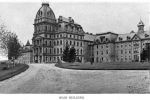Difference between revisions of "Portal:Featured Article Of The Week"
M-Explorer (talk | contribs) |
M-Explorer (talk | contribs) |
||
| Line 1: | Line 1: | ||
{{FAformat | {{FAformat | ||
| − | |Title= | + | |Title= Greystone Park State Hospital |
| − | |Image= | + | |Image= Greystone1.png |
|Width= 150px | |Width= 150px | ||
| − | |Body= | + | |Body= Originally opened on August 17, 1876, the hospital was known as the New Jersey State Lunatic Asylum at Morristown. The asylum officially received the familiar Greystone Park name in 1924. The idea for such a facility was conceived in the early 1870s at the persistent lobbying of Dorothea Lynde Dix, a former school teacher who was an advocate for better health care for people with mental illnesses. Because of her efforts, the New Jersey Legislature appropriated $2.5 million dollars to obtain about 3.007 square kilometers (743 acres) of land for New Jersey’s second "lunatic asylum." Great care was taken to select a location central to the majority of New Jersey's population near Morristown, Parsippany, and Newark. The land Greystone was built on was purchased by the state in two installments between 1871 and 1872 for a total of $146,000. |
| − | + | At this time in history, New Jersey's state-funded mental health facilities were exceedingly overcrowded and sub par compared to neighboring states that had more facilities and room to house patients. Greystone was built, all 62,589 m² (673,706 ft²) of it, in part to relieve the only — and severely overcrowded — "lunatic asylum" in the state, which was located in Trenton, New Jersey. In fact, Greystone's initial 292 patients were transferred from the Trenton facility to Greystone based on geographic distribution, setting precedent for Greystone to become the facility that would generally accept patients whose residences were in the northern part of the state. This proved to be the very reason why Greystone quickly became overcrowded in the heavily-populated North while the Trenton facility's number of patients remained relatively stable in the sparsely populated South. [[Greystone Park State Hospital|Click here for more...]] | |
| − | |||
| − | |||
| − | |||
| − | |||
}} | }} | ||
Revision as of 04:03, 19 August 2013
Featured Article Of The Week
Greystone Park State Hospital
Originally opened on August 17, 1876, the hospital was known as the New Jersey State Lunatic Asylum at Morristown. The asylum officially received the familiar Greystone Park name in 1924. The idea for such a facility was conceived in the early 1870s at the persistent lobbying of Dorothea Lynde Dix, a former school teacher who was an advocate for better health care for people with mental illnesses. Because of her efforts, the New Jersey Legislature appropriated $2.5 million dollars to obtain about 3.007 square kilometers (743 acres) of land for New Jersey’s second "lunatic asylum." Great care was taken to select a location central to the majority of New Jersey's population near Morristown, Parsippany, and Newark. The land Greystone was built on was purchased by the state in two installments between 1871 and 1872 for a total of $146,000.
At this time in history, New Jersey's state-funded mental health facilities were exceedingly overcrowded and sub par compared to neighboring states that had more facilities and room to house patients. Greystone was built, all 62,589 m² (673,706 ft²) of it, in part to relieve the only — and severely overcrowded — "lunatic asylum" in the state, which was located in Trenton, New Jersey. In fact, Greystone's initial 292 patients were transferred from the Trenton facility to Greystone based on geographic distribution, setting precedent for Greystone to become the facility that would generally accept patients whose residences were in the northern part of the state. This proved to be the very reason why Greystone quickly became overcrowded in the heavily-populated North while the Trenton facility's number of patients remained relatively stable in the sparsely populated South. Click here for more...
